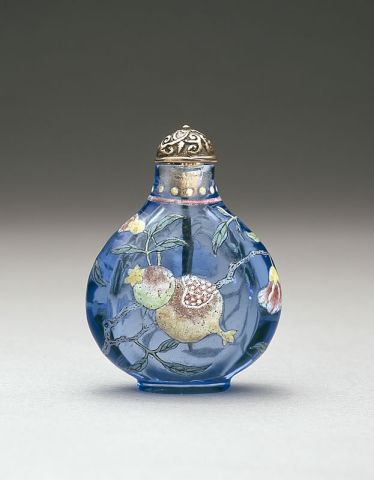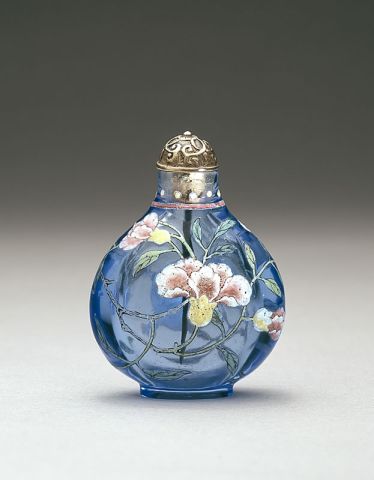

Bottle ID: 00677
BLUE, FAMILLE ROSE, POMEGRANATES & FLOWERING LOTUS
Date: 1736
Height: 42 mm
Glass, of small rounded flattened form, the shoulders tapering to a slightly everted mouth and with a neatly carved footrim, of a clear sapphire-blue decorated in famille rose enamels with a continuous design of leafy branches of two fruiting and flowering pomegranates, one fully ripe with its skin split to reveal the seeds within, amidst five flowering lotus, beneath a border at the neck of yellow dots above a pink band.
Imperial, attributed to the Palace Workshops, Beijing.
Similar Examples:
Chang Lin-sheng. Snuff Bottles in the Collection of the National Palace Museum, Taipei, Taiwan, 1991, p. 111, no. 73.
Moss, Hugh, Victor Graham and Ka Bo Tsang. The Art of the Chinese Snuff Bottle - The J & J Collection, 1993, Vol. I, pp. 306-307, no. 183.
Provenance:
Hugh Moss [HK] Ltd.
Universal, Taipei, 2005
Lin Collection, Taipei, December 2005
Exhibited:
Annual Convention ICSBS Toronto, October 2007
Published:
JICSBS, Winter 2008, p. 5, figs. 3a and 3b
On the seventeenth day of the fifth month, 1736, Eunuch, Mao Tuan, delivered an Imperial decree to the Palace Workshops to fire 'soft' enamels on glass to be inspected by the Emperor. Three days later, treasurer Liu Shangui and Head Eunuch, Samuha, delivered two 'soft' enameled, transparent blue glass snuff bottles to Mao Tuan to present to the Emperor. His response was that there are not enough flowers on the snuff bottle and that next time, more flowers should be painted and further, that all pieces should have a reign mark. In the following year of 1737, between the third and the seventh month, eleven more bottles were made following these instructions.
This intriguing piece of information, unearthed by Hugh Moss, seems highly relevant to this very bottle, since the description of the two bottles to be made for the Emperor allow for a very close comparison to be made with the Crane bottle. The Crane example is of a clear blue glass, typical of the early eighteenth century glass that was produced from the Yongzheng period onwards. Although this piece is not crizzled, many glass pieces from this early period were, and in particular, the color tones of clear and blue glass seemed to fall prey to this phenomenon. However, the lack of a fault in the glass does not necessarily exclude it from this date range. The flowers enameled on this bottle, despite its small size, are fairly sparse both spatially and in terms of variety; there being only pomegranates and lotus.
By the early Qianlong period, the Imperial workshops had established guidelines for painting enamels. There were essentially four methods which were used by the painters. The first was known as the 'boneless' technique, derived from the painting style of Yun Shouping, where there was no outline for individual parts of the decoration so that the enamel was freely painted from the design. The second was to use an outline for the design but in the same color enamel as the 'filler' color. For example, to paint a flower-head in ruby-red, the petals would be outlined individually in ruby-red first. The third method used a different color enamel, usually black or gray, to outline the design before it was filled in, while the fourth method used iron-red enamel in a similar way. The last method was taken up by the enamellers of Guyue Xuan marked bottles and is found on the majority of these bottles.
The Crane example, however, seems to be a prototype of the three methods of outlining, being of a grayish-purple tone. Interestingly, the similar example in the National Palace Museum, which is on ruby-red glass, is outlined with a brownish iron-red enamel. The problems with firing enamels on glass that occurred early on is very evident on the Crane bottle with heavy pitting, particularly of the opaque reds, pinks and yellow, and in the slightly worn look of the delicate enamels. The simplicity of the neck border is also a feature of decoration of the Yongzheng and the early Qianlong period, helping to date the bottle to the very first years of the Qianlong period.
The Qianlong Emperor in his response to the two bottles presented by the Eunuch, demands that in the future all of these bottles should be made with a reign mark put on them. Since there is no evidence of any basemark on the Crane example, there is a possibility that this could have been one of the two bottles presented to the Emperor. Most Yongzheng glass pieces are attributed to the reign on the basis of other features since reign marks were not common until the Qianlong period when they became standard. Perhaps it is fanciful to think that this is one of the two bottles seen by the Emperor, but it is certainly not outside the realms of possibility, and as such, it adds an imaginative dimension to the Crane bottle.
< Back to full list

 English
English 中文
中文